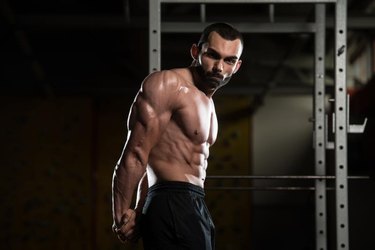
Alright, you don't need to bounce your pecs. It serves no muscle-building or fitness-related purpose, and even if you're on a competitive bodybuilding stage, chances are the judges won't ask you to make your chest dance.
But there is one very worthwhile reason to do a pec bounce: Because it's fun. And if you can't have a little fun with your hard-earned results, what's the point of working out, anyway?
Video of the Day
Video of the Day
Read more: How to Flex Pecs
Origins of the Bounce
At the peak of bodybuilding as a form of vaudevillian entertainment in the late 1800s, legendary strongman Eugen Sandow showed off his muscle control by isolating specific muscles like the biceps and making them flutter. The father of modern bodybuilding might not have twitched his pecs, but his trick can be viewed as the origin of the basic concept.
Fast forward to the 1970s, and the chest sizes of bodybuilders reached epic proportions, likely due to the use of steroids that were officially banned by the International Federation of Bodybuilding and Fitness, but still legal to use recreationally. Though it's impossible to pin down the first person to pec bounce, Arnold Schwarzenegger famously — and very publicly — pulled off the move at the 1972 Mr. Olympia competition. And the rest is pectoral history.
The Technique
Though your inclination might be to start with your pecs flexed, they dance best when they're relaxed. The very act of tensing the relaxed pecotral muscles and then letting them go loose again is what makes the chest appear to "dance" (and why heftier pecs seem to move more), so you want to start loose.

Now give the clavicular head of your pectoralis major a good twitch. This is the thin muscle fiber just under your collarbone that connects your upper pecs to your outer shoulders, and if you haven't been exercising it, you'll need to start if you want those babies to dance.
Focus on pulling this muscle upward; that's what enables the rising movement of the pec. Relax the clav and let the pec fall to complete one "bounce." Again, this should be a quick, strong contraction like a twitch rather than a prolonged engagement of the muscle.
Experiment with different arm positions to see what helps you engage the clavs best. You might find that you can pop the pecs better with your arms relaxed at your sides, held behind your back or clasped at your belly. Try bouncing one pec at a time, then another, then go in turns till you eventually work your way up to bouncing both at once. It'll take plenty of practice before your pecs are ready to dance to a party beat.
Read more: The Best Upper Chest Workout
Sharing the Bounce
Remember that pec popping also relies a bit on luck of the draw; some people, perhaps due to plain old genetic predisposition, just might not be able to pec bounce, no matter how fit they are.
And as you might have guessed, making your pecs dance isn't an exact science. So if you readers have any pec-jiggling tips or tricks to share, enlighten us with your bouncy ways in the comments below.